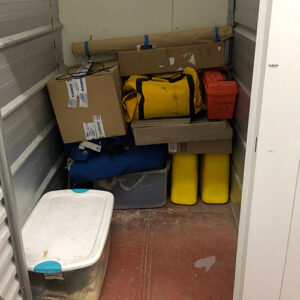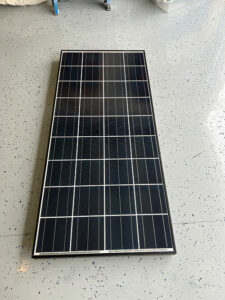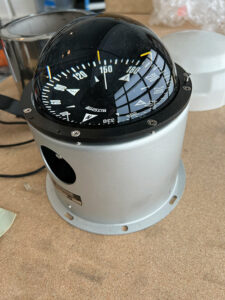
We all know the old saw about the best two days in a boater’s life. But I’d like to nominate a third: the day you finally get rid of all that excess gear.
My wife, Deborah, and I are the very opposite of hoarders. Over the years, we have ruthlessly purged our home of clutter and unnecessary items. We love the lightness of having exactly what we need and love, but not much more.
The boat, though, is a different beast. Old, used, and obsolete boat gear is difficult to get rid of. Like a virus, the leftovers of boat upgrades, preventative maintenance, and — worst of all — projects you planned to start but never did, have the ability to pass right through my otherwise bulletproof anti-clutter defenses.
The justifications come easy enough. You can’t have enough spares! Hey, those tired mooring lines might come in handy. I’ll use this UV-damaged fender for a man overboard drill. Someone might want to use this 15-year-old solar charge controller. This handheld GPS unit cost a fortune back in the day. And on and on.
It creeps up slowly, over years, one piece, coil or half-empty can after another. You manage first by organizing them in piles. Then in crates. Then you start stacking the crates up higher and higher. Then you make more space with shelves. And finally, you find that at some point you’ve crossed a line that you never thought you would — you rent a storage unit.
After four boats and a long process of refits, I had amassed a good deal of unnecessary gear. I told myself I didn’t have a problem, because I kept a neat and organized boat. I kept most of the extra boat gear shoreside and even culled through the mess from time to time. I had a plan for almost all of it — this part would be useful for that one project (that has sat on the nice-to-do-list for years). Or I bet I could get a pretty penny for this at the swap meet (which I probably won’t end up going to).
I hit the old rock bottom when I realized I had a roll of sail repair tape that my dad had bought for his boat … in 1978.
Holding that in my hand, standing before the open metal door of the self-storage unit near our marina, I started doing the math. A hundred dollars a month for the space seemed reasonable at the time. But $100 a month means $1,200 a year. And since I had the place for five years, I had spent $6,000 to store boat stuff that I mostly hadn’t needed or used. That was insane.
I had fallen into the trap of false economies. I could have bought most of the stuff in my locker brand new for the amount of money I had spent hanging on to it. I needed to fix this situation. But the question was how to do it.

Sorting the mess
I started by going through everything in that storage unit and sorting it with a dispassionate eye into several categories.
First were items that actually could be used as critical spare parts. The engine alternator from my first boat didn’t make the cut. But the working alternator I had replaced with an upgraded version from my current boat did.
Next were items that I would definitely use on a boat project in the next year. For example, I had spools of tinned copper green wire that would be perfect for replacing the bonding on our boat. Another was the rudder angle indicator equipment that came with the autopilot I had installed a few years back. I was just waiting to put that piece of optional equipment in until after I had finished a rudder and steering gear upgrade that was underway.

The third category was items that I could reasonably expect to sell or that might still have real value. For example, I had been given for next to nothing an entire 1984 vintage Edson steering pedestal, complete with Danfoss compass, throttle, idlers and associated equipment. It was all unused, mostly still in the original packaging.
The fourth category was items that someone might really be able to use, but that would be unlikely to have any resale value. This pile grew quickly. It included the old mooring lines, the mildew-spotted orange life vests, old blocks and running rigging, the handheld VHF radio and pre-map-enabled GPS unit, shackles, hose clamps and hose cutoffs that didn’t make the spares category.
Into this pile I also put items that were made specifically for my make and model of boat but which had been replaced by different equipment. These I would offer to other owners of Passport 40s in case they needed to replace those specific items on their own boats and didn’t want to go through the hassle of getting something new or custom made. This included such things as the old emergency tiller, an old staysail, and a radial drive for the rudder post.
The fifth and final category was the junk pile. Old cans of varnish, sealants well past their pull dates, half-filled cans of paint, old flares, and a lot more. A number of these items required special disposal facilities.
Each of these categories went through at least one more steely-eyed sorting, with a significant number of items moving one category down.
Finding a new home
I spent about a month advertising a handful of items for sale on the usual classified ad websites. Even though I had priced various items as a good deal, I found that in most cases I had to drop the price further to sell them. But in some cases, I was gratified with the result — even if the money didn’t really amount to much. For example, the pedestal, steering gear, and compass went to a nonprofit program in Brazil that helps train young people in boat building and seamanship. If all goes well, those pieces will sit proudly in the cockpit of the school’s boat.
There is an active owners group for our type of boat, and almost all of the gear found new homes with appreciative skippers. I’m hoping it earns me a few good karma points, because the only recompense I sought was the cost of shipping.
I took a load of useful but unsold items to one of the used parts chandleries nearby. Rather than the hassle of selling them on consignment, I turned over the lot to the owner in exchange for $100. It was a way to support a business I appreciated and, hopefully, will mean those items eventually find a new home.
When all was said and done, I had just a few crates left stacked in my garage. Slowly, I’ve been reducing those as I dip into them for real winter projects.
It felt like I had achieved a boating milestone the day I walked into the self-storage office and signed the paperwork giving up my unit. The bored clerk must have wondered why I was beaming as I signed my name on the release form.
The weight of all those things had finally lifted and it felt like the metaphorical waterline of my boat ownership had lifted a few gratifying inches. I finally had what I needed and loved for the boat, but not much more. And that feels great.
Marty McOmber is a Pacific Northwest sailor, writer, and strategic communications professional. He is currently working on refitting and improving his 1984 Passport 40, Rounder, for continued cruising adventures near and far.







